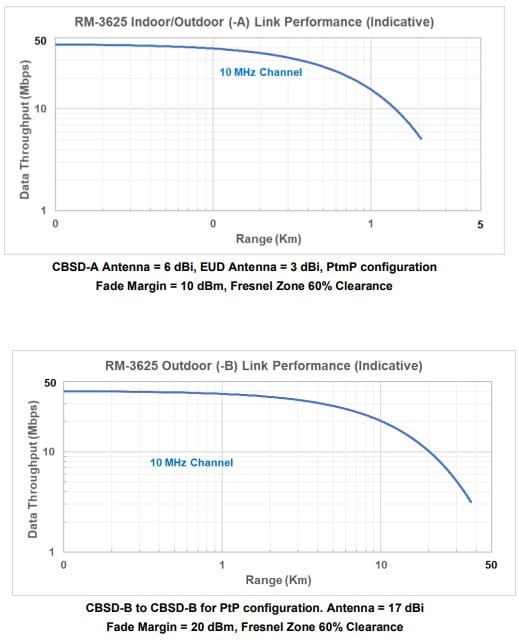Mesh Rider® Radio Platform
Mesh Rider® Radio provides resilient, low latency, long-range, high-throughput links to implement industrial-grade private wireless mobile mesh Networks.
CBRS 3.6 GHz Band
New Interference Free CBRS innovation Band (Citizens Broadband Radio Service) in the USA A large swath (150 MHz) of a new spectrum has been released by FCC to enable innovations in wireless applications. For reference, the popular WiFi band is only 82 MHz of spectrum. The band provides interference protection by dynamic frequency coordination amongst users. For more details, check out our Mesh Rider solution for the newly released CBRS band. Doodle Labs has leveraged it’s patented Mesh Rider technology to provide a non-LTE based ultra-fast, IP radio solution for this band. The radio has been fully certified by FCC.
Key Features
Low SWaP
Performance RF
Fast Integration
Long Range
Mesh
Frequency Flexibility
C&C + Video
Affordable

Mesh Rider®
A small, high performance mesh radio designed for unmanned systems. The Embedded Smart Radio is a robust radio incorporating all the benefits of Mesh Rider in a SWaP (Size, Weight and Power) optimized form factor.
Common Integrations
Drones/UAVs
UGVs
AMRs
Mobile Robotics
Link Distance
Mesh Rider® Radio’s Mesh Rider waveform has been field proven by customer to provide a link over 100km. The link distance of each system, however, depends on many factors: mainly antenna gain, line of sight obstructions, Fresnel zone clearance, and environmental noise conditions. The chart below give an indication of radio’s performance in a typical configuration.
RM-3625 Xtreme Link Performance

| PERFORMANCE OVERVIEW | |
|---|---|
| Protocol Compatibility | Fully compatible with Mesh Rider Waveform |
| Embedded, External: Max Operating Range (Indicative) | 40 Km (Recommended) |
| Over the Air Data Encryption | 128-bit AES hardware data encryption @ full rate, 256-bit AES software data encryption @ 12 Mbps |
| Operating Modes | Gateway/AP (CBSD-A), Rural Gateway/AP (CBSD-B), Transparent Client Bridge (EUD-A), Transparent Client Bridge (EUD-B) |
| Command & Control Channel | Ultra-Reliable Low Latency Channel (URLLC). Latency 1.5-10 ms |
| Video Channel | Optimized video streaming with Unicast and Multicast transmission |
| Mesh Automatic Transmit Power Control | Intelligently adjusts Tx output power based on signal strength. Allows the device to be utilized in a dispersed and dynamic mesh. |
| RF SPECIFICATIONS | |
|---|---|
| Radio Configuration | 2x2 MIMO |
| Frequency Range | 3550-3700 MHz (Supports GA and PAL users) |
| Max RF Power at SMA port (Software control) Each radio individually calibrated | 1W, 30 dBm @ MCS 0, 8 1W, 30 dBm @ MCS 3, 11 400mW, 26 dBm @ MCS 5,13 250mW, 24 dBm @ MCS 7, 15 |
| Channel Aggregation | Up to 4 channels |
| Channel Sizes (Software Selectable) | 3, 5, 10 MHz |
| Radio Data Rate (Modulation Coding Scheme – MCS) | Dynamic Link Auto Adaptation |
| Antenna Signal Strength | -25 to -85 dBm (Recommended), Absolute Maximum= +12 dBm |
| Embedded & External: Receiver LNA Gain | >20 dB |
| RF Power Control | In 1 dBm steps, Tolerance ±1 dBm |
| Automatic Transmit Power Control (ATPC) | Intelligently adjusts the transmit power for very close range operation |
| Integrated Antenna Port Protection | Able to withstand open port, >10 KV (contact) and >15KV (open air discharge) as per IEC-61000-4-2 |
| Wireless Error Correction | FEC, ARQ |
| Frequency Accuracy | ±10 ppm max over life |
| NETWORKING SPECIFICATIONS | |
|---|---|
| Mesh Router | Self-Forming/Self-Healing, Peer to Peer |
| Custom Software Package Manager | Image Builder, OPKG, ipk |
| Radio Management | Web GUI (HTTPs), SSH, SNMP and JSON-RPC |
| Access control | Password, MAC, IP, Port filtering |
| Supported Protocols | IPv6, QoS, DNS, HTTPS, IP, ICMP, NTP, DHCP |
| Software Upgrade | Over the air software upgrade supported |
| ADDITIONAL MESH RIDER RF SPECIFICATIONS (Applies to all CBSD and EUD models | |
|---|---|
| Radio Data Rates (Dynamic Link Auto Adaptation) | MCS15 = 64QAM (5/6) MCS14 = 64 QAM (3/4) MCS13 = 64 QAM (2/3) MCS12 = 16QAM (3/4) MCS11 = 16QAM (1/2) MCS10 = QPSK (3/4) MCS9 = QPSK (1/2) MCS8 = BPSK (1/2) MCS7 = 64QAM (5/6) MCS6 = 64 QAM (3/4) MCS5 = 64 QAM (2/3) MCS4 = 16QAM (3/4) MCS3 = 16QAM (1/2) MCS2 = QPSK (3/4) MCS1 = QPSK (1/2) MCS0 = BPSK (1/2) |
| Rx Sensitivity (10 MHz Channel BW) | -96 dBm @ MCS 0 -93 dBm @ MCS 1 -91 dBm @ MCS 2 -88 dBm @ MCS 3 -83 dBm @ MCS 4 -81 dBm @ MCS 5 -78 dBm @ MCS 6 75 dBm @ MCS 7 -93 dBm @ MCS 8 -89 dBm @ MCS 9 -87 dBm @ MCS 10 -84 dBm @ MCS 11 -80 dBm @ MCS 12 -76 dBm @ MCS 13 -75 dBm @ MCS 14 -74 dBm @ MCS 15 |
| Rx Sensitivity (5 MHz Channel BW) | -98 dBm @ MCS 0 -95 dBm @ MCS 1 -93 dBm @ MCS 2 -90 dBm @ MCS 3 -85 dBm @ MCS 4 -83 dBm @ MCS 5 -80 dBm @ MCS 6 -77 dBm @ MCS 7 -95 dBm @ MCS 8 -91 dBm @ MCS 9 -89 dBm @ MCS 10 -85 dBm @ MCS 11 -82 dBm @ MCS 12 -78 dBm @ MCS 13 -77 dBm @ MCS 14 -76 dBm @ MCS 15 |
| Rx Sensitivity (3 MHz Channel BW) | -100 dBm @ MCS 0 -97 dBm @ MCS 1 -95 dBm @ MCS 2 -92 dBm @ MCS 3 -87 dBm @ MCS 4 -85 dBm @ MCS 5 -82 dBm @ MCS 6 -79 dBm @ MCS 7 -97 dBm @ MCS 8 -93 dBm @ MCS 9 -91 dBm @ MCS 10 -88 dBm @ MCS 11 -84 dBm @ MCS 12 -80 dBm @ MCS 13 -79 dBm @ MCS 14 -78 dBm @ MCS 15 |
| Receive Adjacent Channel Rejection (ACR) | >34 dB @ 6 Mbps (Typ) |
| Receive Noise Figure | +4 dB |
| Transmitter Adjacent Channel Leakage Ratio (ACLR) | -28 dBr (Fc ± ChBW) |
| Transmitter Spurious Emission Suppression | -55 dBc |
| REGULATORY INFORMATION | |
|---|---|
| FCC ID | 2AG87-RM3625 |
| Regulatory Requirements | Designed and verified to meet various regulatory requirements. Formal testing and approval are required for the Integrator’s antenna type. The integrator is responsible for obtaining all regulatory approvals in target markets for the finished product. |
| RoHS/WEEE Compliance | Yes. 100% Recyclable/Biodegradable packaging |
| MESH RIDER RADIO PLATFORM -3550-3700 MHz | ||
|---|---|---|
| Form Factors |  |  |
| Model Code | RM-3625-2J-UDB-MG (Industrial) | RM-3625-2J-UDB-EG (Industrial) |
| Dimensions | 65 x 57 x 12 mm | 148 x 137 x 58 mm |
| Weight | 78 grams (Embedded) | 540 grams (External) |
| Operating Voltage | 6~42V DC | 6~42V DC |
| Host Interfaces | 2x Ethernet (100 Base-T) and UART (3.3V FT234XD chipset) OR USB 2.0 Hub ports | 2x Ethernet (100 Base-T), 1x UART (3.3V FT234XD chipset), and 2x USB 2.0 Hub ports |
| Antenna Connection | 2x MMCX-Female connectors | 2x SMA-Female |
| Temperature range (Operating) | Industrial: -40°C to +85°C, Commercial: -10°C to +65°C External Temp: Up to +40°C (Wearable) System’s thermal design should ensure that the radio’s case temperature is maintained within these specifications |
|
| Temperature range (Non-Operating) | -40°C to +100°C | |
| Ingress Protection | IP 50, Dust Protected, No Liquids | IP66, resistant to strong jets of water . |
| Relative Humidity | 5% to 95% noncondensing | |
| Shock and Vibration Resistance | Compliant to MIL-STD-810H for high shock and vibration | |
| DC Power Consumption | 14W @ Max RF power in UDP data Tx mode 2W in data Rx mode 1.2W in Sleep mode | 14W @ Max RF power in UDP data Tx mode 2W in data Rx mode 1.2W in Sleep mode |
| Reliability | Extreme Reliability, IPC Class 2 standard with Class 3 options | |
| Integrated GPS (Optional) | Simultaneous multiple constellations (GPS/Galileo/Glonass/BeiDou/QZSS), 1.5 meter CEP position accuracy, -163 dBm tracking sensitivity | Simultaneous multiple constellations (GPS/Galileo/Glonass/BeiDou/QZSS), 1.5 meter CEP position accuracy, -163 dBm tracking sensitivity |
| Integrated CPU | MIPS 24K, 540 MHz, 32MB Flash, 64MB DDR2 RAM | |
| ESD Protection | IEC 61000-4-2 test criteria, Level 3 (±6KV) for Contact Discharge and Level 4 (±15KV) for Air Discharge |
|
| MTBF | >235k hours (25 years) | |
| Life Cycle Planning | Extended lifespan with 7 years guaranteed availability | |
Loading...
